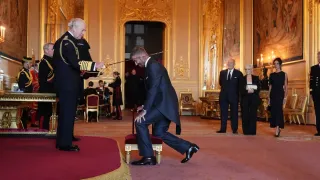
4 hours ago
Queer, Sober, and Seen: Why More LGBTQ+ Folks Are Saying ‘No Thanks’ to Booze
READ TIME: 4 MIN.
For decades, queer liberation has sparkled beneath disco balls and bled neon under club lights. Our histories are written on dance floors—safe havens where chosen families found each other, even when the world outside shut the door. But the soundtrack of queer nightlife has often been laced with another constant: alcohol—and, for many, the tangled complications it brings.
It’s no secret that LGBTQ+ folks have faced disproportionately high rates of substance use. According to the Substance Abuse and Mental Health Services Administration, LGBTQ+ adults are more than twice as likely to use illicit drugs and 2.5 times more likely to abuse alcohol than their heterosexual peers . A staggering 25% of LGBTQ+ people abuse alcohol, compared to just 5-10% of the general population . For many, the bottle was both a shield and a ticket to belonging—a way to numb the pain of discrimination, rejection, and daily microaggressions, or simply to access community when queer-friendly spaces meant bars and nowhere else .
Yet, a new current is stirring in our cultural cocktails: queer sobriety. Across major cities, small towns, and online enclaves, more LGBTQ+ folks are questioning the old scripts. What if queer joy didn’t have to come with a hangover?
The roots of queer substance use run deep, entwined with histories of trauma, exclusion, and survival. As one young nonbinary activist put it at a recent sober Pride event, “Drinking was how we survived a world that didn’t want us. But now, living fully—clear-eyed and present—feels like the most radical act” .
Alcohol wasn’t just a party favor—it was armor against a hostile world. Facing higher rates of depression, anxiety, and suicidal ideation, LGBTQ+ youth are particularly vulnerable: nearly 50% of queer youth between ages 12 and 17 report substance use, and LGBTQ+ adolescents are twice as likely as their peers to try and regularly abuse substances .
But something is shifting. Sober queer collectives are emerging, from drag brunches with mocktail menus to alcohol-free dance parties and storytelling nights. The message? Queer connection isn’t defined by what’s in your cup, but by who you are and how you show up. “We’re building new blueprints for queer joy,” says Maya, a co-founder of a Brooklyn-based sober social club. “For the first time, I feel like I belong—no numbing required” .
Why the shift now? Partly, it’s generational: younger queer folks are openly challenging the equation of pride with excess. There’s an increased awareness of how trauma, discrimination, and the stress of hiding one’s identity have driven risky coping mechanisms . More queer people are seeking therapy, community care, and holistic wellness—resources once out of reach due to stigma or lack of access .
But it’s also about reclaiming agency. “Sobriety isn’t just abstaining from alcohol—it’s about choosing presence over dissociation, pleasure over pain,” says Alex, a trans man and peer support group leader in Chicago. “For so long, we’ve been told that our joy is dangerous, or that we need to dull ourselves to survive. Now, we’re saying: we want all of ourselves, in every color” .
Importantly, queer sobriety isn’t about respectability politics or shaming those who drink. Instead, it’s a movement that holds space for nuance: joy, grief, and the messy realities of being human. “There’s no one way to be queer, and no one way to be sober,” notes Maya. “Some people never drank. Others are in recovery. Some are just tired of the scene. All are welcome” .
The shift toward sober queer spaces is also a response to the lack of affirming, alcohol-free alternatives. Despite higher rates of substance use, only 7.4% of treatment facilities offer specialized programs for LGBTQ+ patients . Many queer folks report delaying treatment due to fears of discrimination, while others simply crave spaces where they don’t have to explain themselves or fend off assumptions .
Enter a new generation of queer entrepreneurs and organizers. Across the country, sober bars, dry Pride events, and wellness retreats are blossoming. Instagram accounts like @SoberQueerCollective and organizations such as Queer Sober Spaces are amplifying the message that “sober is sexy—and here to stay.”
For some, this means reimagining what queer celebration looks like. “We used to think Pride meant pounding drinks and being outrageous,” says Elle, who helps organize a sober drag show in Los Angeles. “Now, it’s about radical honesty, creative expression, and finding joy in our bodies and each other—no matter what we’re drinking” .
Of course, not everyone is ready to trade in their vodka sodas for mocktails. For some, the traditional nightlife scene remains a vital site of resistance, flirtation, and fun. But even here, the conversation is evolving. More clubs and event organizers are offering non-alcoholic options, hosting “sober hours,” and making harm reduction part of their ethos.
Queer sobriety is not a rejection of the past, but an evolution—one that honors the resilience of generations who made joy possible, even when the world tried to take it away. It’s about expanding what’s possible, so that every LGBTQ+ person can find a place to belong, whether their Pride toast is bubbly or bone-dry.
As Maya puts it: “We’re not just surviving anymore. We’re thriving—together, and on our own terms.”
Raise a glass—of whatever you fancy—to that.






